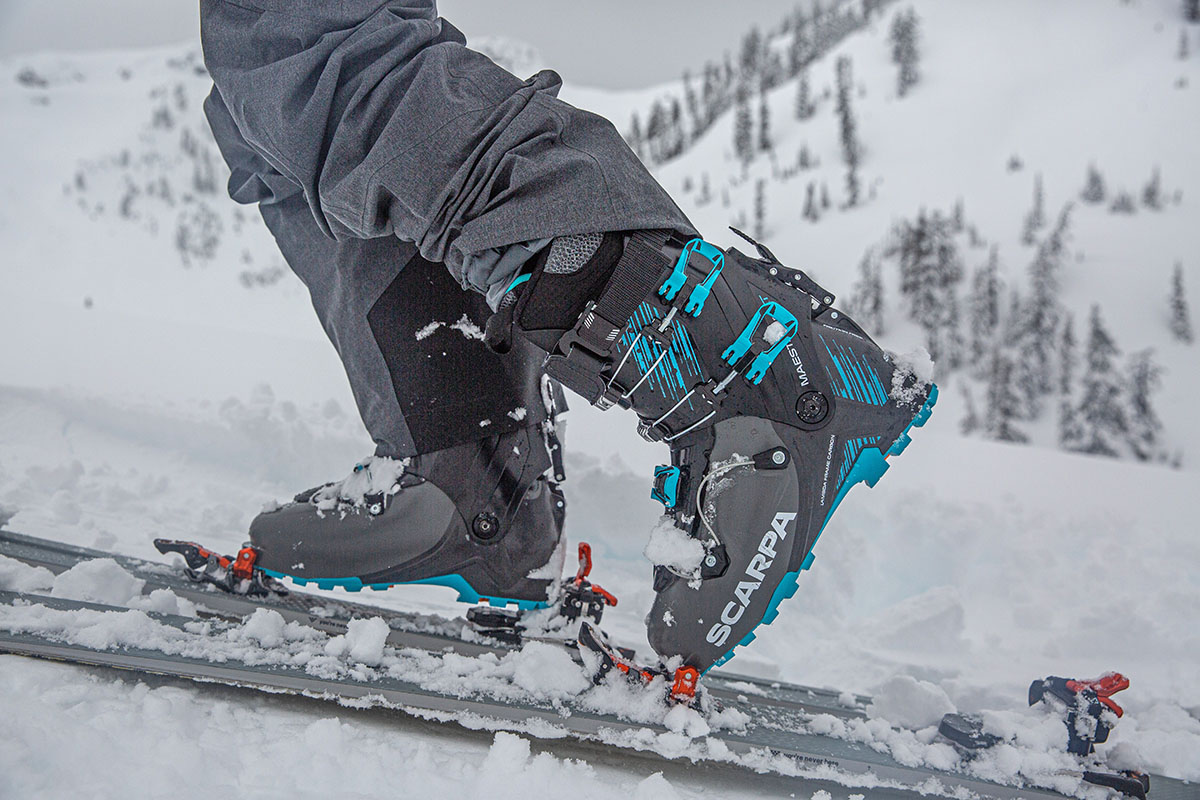
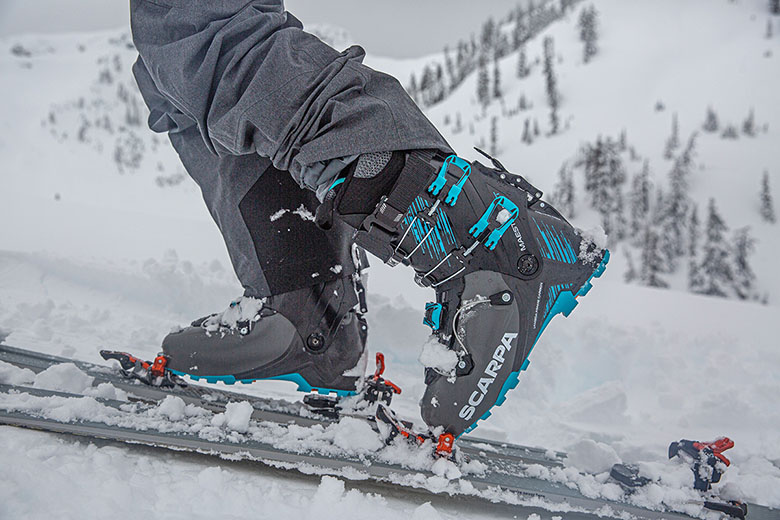
Price: $929
Weight per pair: 6 lbs. 9.8 oz. (size 28)
Flex: 130
What we like: A supremely capable downhill-focused boot with surprisingly good touring capabilities.
What we don’t: Expensive and best suited for advanced, hard-charging riders.
See the Scarpa Maestrale XT
Scarpa’s Maestrale RS boots are legendary among backcountry skiers and well loved for their effective balance of uphill and downhill performance. Introduced a couple seasons ago, the XT version unapologetically favors the latter, combining added stiffness and rigidity for a locked-in and confidence-inspiring feel on steep descents. That said, in testing, the XT way exceeded expectations on the climbs with generous range of motion, a grippy outsole, and good adjustability. It's still best suited for hard-charging, experienced riders, but this is more than a one-trick pony. To see how it stacks up to the competition, see our article on the best backcountry ski boots.
The Scarpa Maestrale XT is a decidedly downhill-focused boot, so I was pleasantly surprised to learn that it’s a great uphill companion, too. In terms of mobility, the XT has a total flex (forward and backward) of 56 degrees, which is very generous and provides ample range of motion for ascending. There is a definitive stopping point when the cuff hits the middle of the tongue, but I’ve never felt limited by the amount of forward tilt. For reference, I’ve only had to revert to using the heel risers on my G3 Ion bindings a few times on particularly steep slopes. On the flip side, the Maestrale’s rear flex exceeds my foot’s range of motion and makes it easy to navigate tight, techy switchbacks that require awkward kick turns. Bootpacking performance is similarly competitive: Like the RS, the XT is equipped with a capable Vibram Cayman PRO outsole that bites well into everything from hardpack snow to ice and rock. It’s also crampon-compatible with most automatic or semi-automatic models.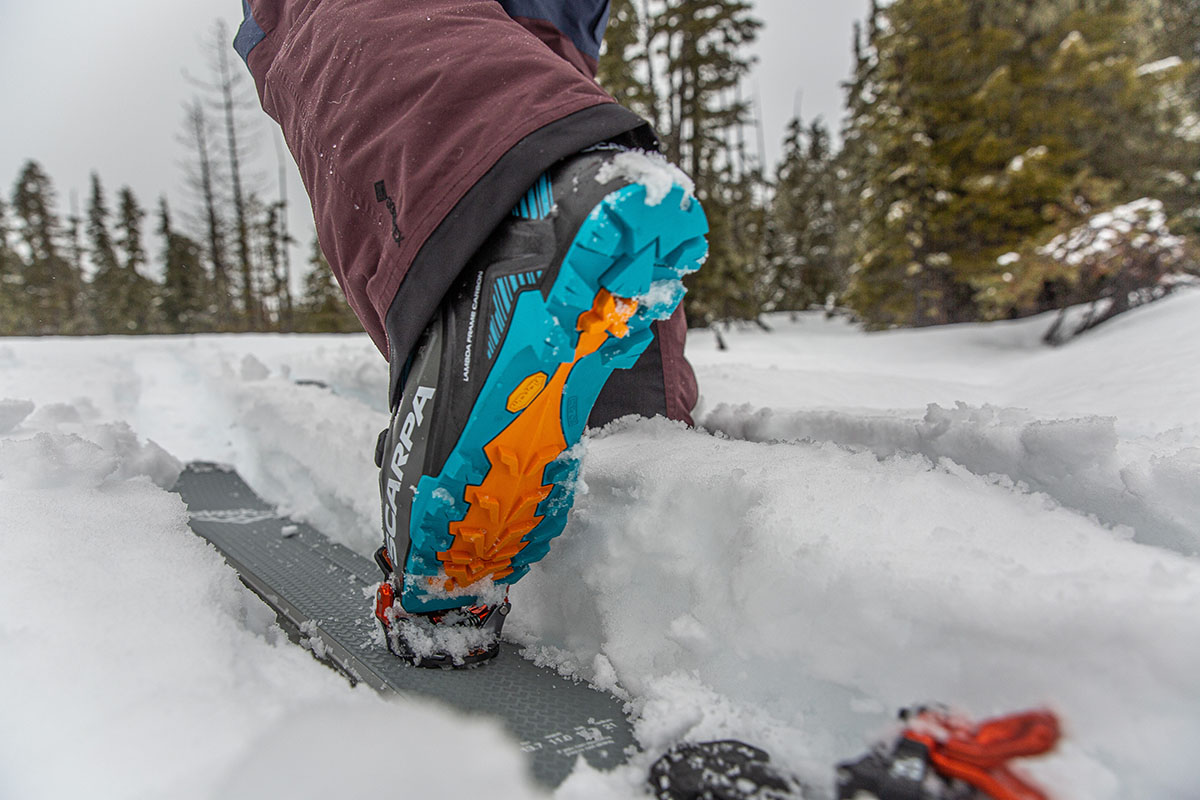
To maximize climbing comfort, I release the top and bottom buckles and loosen the power strap while leaving the buckle at the lower cuff snugly in place. This allows my calf and ankle to flex naturally without my heel moving around sloppily inside the boots. I have found the fit at the front to be a little prohibitive—my toes are slightly scrunched when skinning, which is likely a result of the 2-degree forward lean and lack of ratcheting strap over the forefoot (I cover this more in "Fit and Sizing" below). This has led to some minor toe strikes on more aggressive slopes, but the impact on overall comfort is fairly minimal—and it’s a price I’m willing to pay for the more aggressive fit. All told, I’ve been highly impressed by the Maestrale XT’s climbing abilities and consider it one of the most balanced downhill-focused designs I’ve tested to date.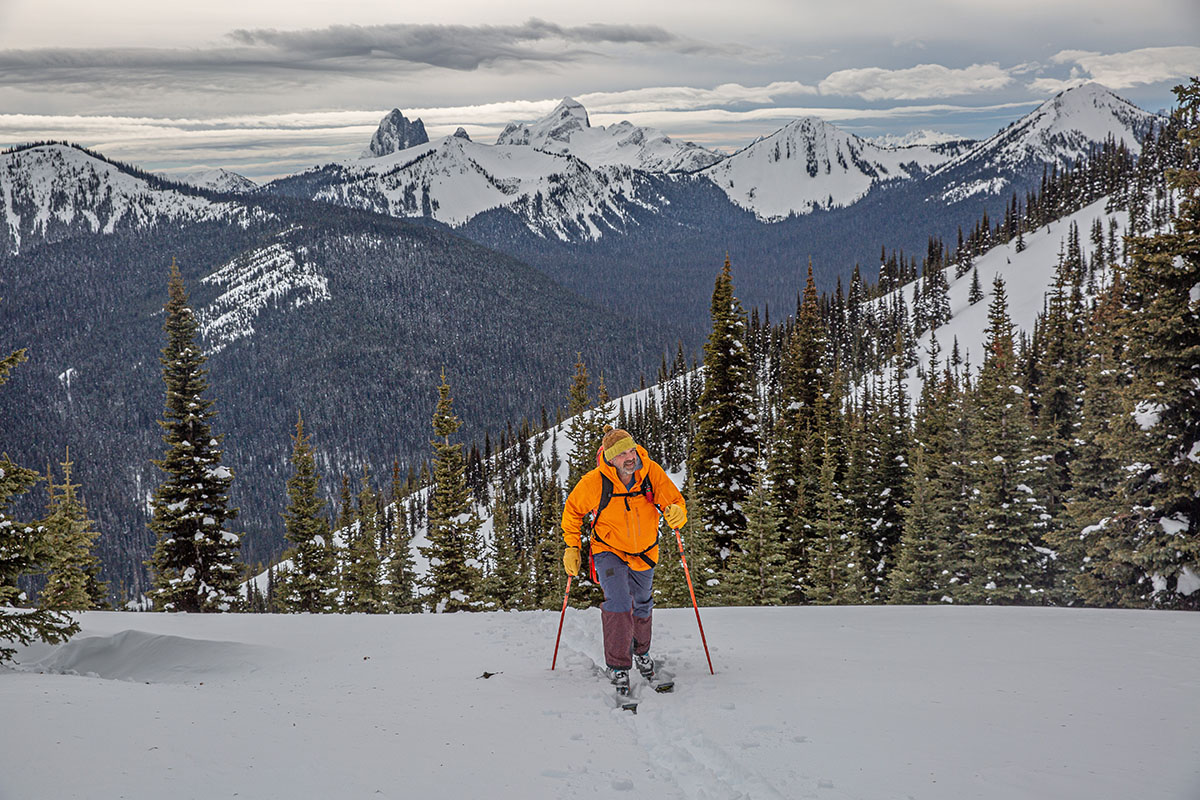
Put simply, the Scarpa Maestrale XT shines when pointed downhill. Despite its great touring abilities, the boot was specifically built to excel on the descent whether you’re lapping frontside groomers or hitting steep lines in the backcountry. My first outing with the Maestrale XT was a day of lift skiing at Vancouver Island’s Mount Washington Alpine Resort, and that downhill prowess was immediately clear: The carbon-infused Grilamid lower shell and large, overlapping cuff provide great torsional rigidity, while the fairly progressive 130 flex allows the boot to drive and transfer energy extremely well. Combined with Scarpa’s Zeppa XT footbed that positions the foot at a 2-degree forward angle, the Maestrale XT offers a remarkably powerful ride and has inspired confidence in conditions ranging from wet and heavy snow to icy hardpack.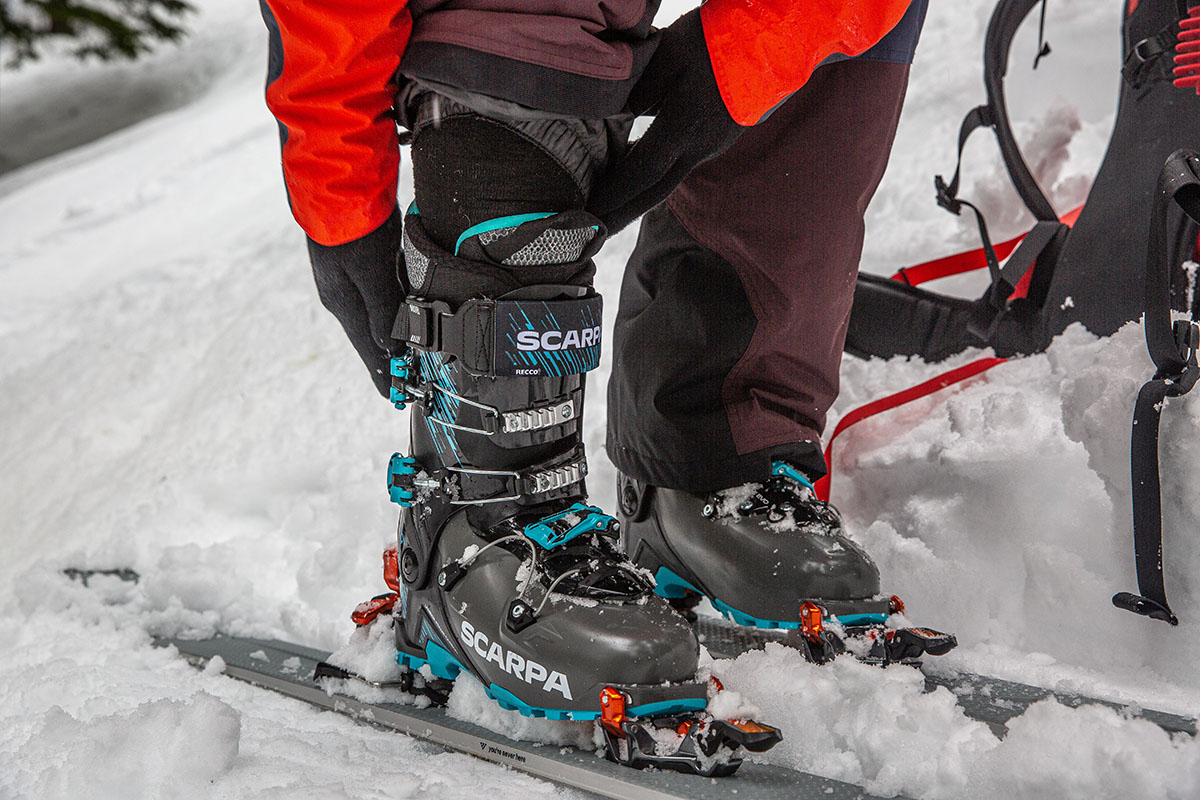
Like the Maestrale RS, the XT is both AT and TLT binding-compatible, and I’ve been using the boot with both the G3 Ion 12 and Salomon S/Lab Shift MNC 13 bindings on skis ranging from 107 to 110 millimeters in width (the Black Crows Corvus and Ferox Freebird). Regardless of which setup I choose, the Maestrale XT feels like a true alpine boot when locked down: The three-buckle design (most downhill-focused competitors have four) provides a surprisingly secure feel, and the stretchy power strap allows me to really lean into the boots and drive hard. Along with the overlapping cuff, it also helps promote a smooth ride when making tight turns and navigating through the trees. Taken together, the Maestrale XT lives up to its billing as a supremely fun and skillful freeride companion.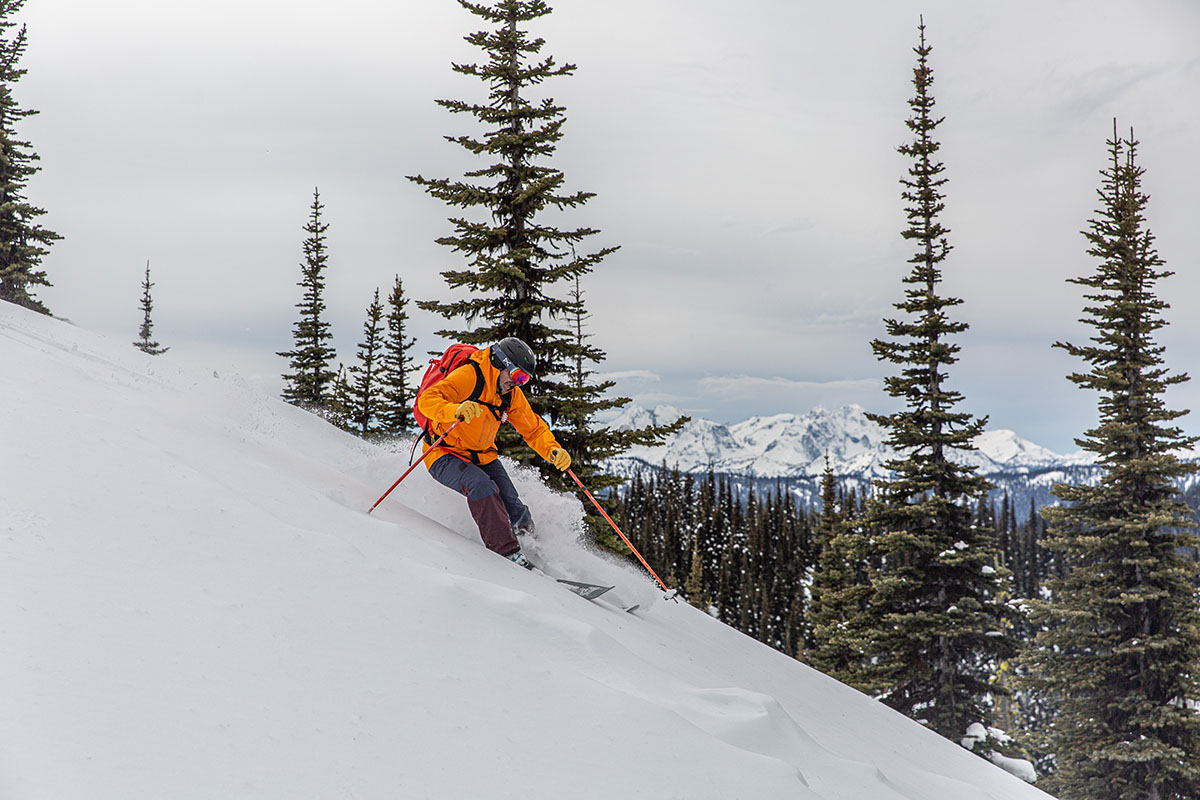
At 6 pounds 9.8 ounces for my pair of size 28 boots, the Maestrale XT is reasonably light given its clear downhill prowess. For reference, it stacks up competitively with other similarly intentioned designs including the Atomic Hawx Ultra XTD 130 CT GW (7 lbs. 0.8 oz.) and Dynafit Hoji Free (6 lbs. 13.3 oz.) while considerably undercutting Lange’s XT3 Free 130 MV GW (7 lbs. 14.3 oz.). And much like its RS sibling (which checks in at 6 lbs. 6.3 oz.), the Maestrale XT incorporates several weight-saving measures, including the carbon fiber-infused Grilamid shell and simple Wave Closure system that combines the function of two buckles into one (more on this below). For reference, I’ve comfortably toured in the boots for six to seven hours without giving a second thought to their heft. In my opinion, the Maestrale XT offers a near-ideal combination of weight and descending capabilities. 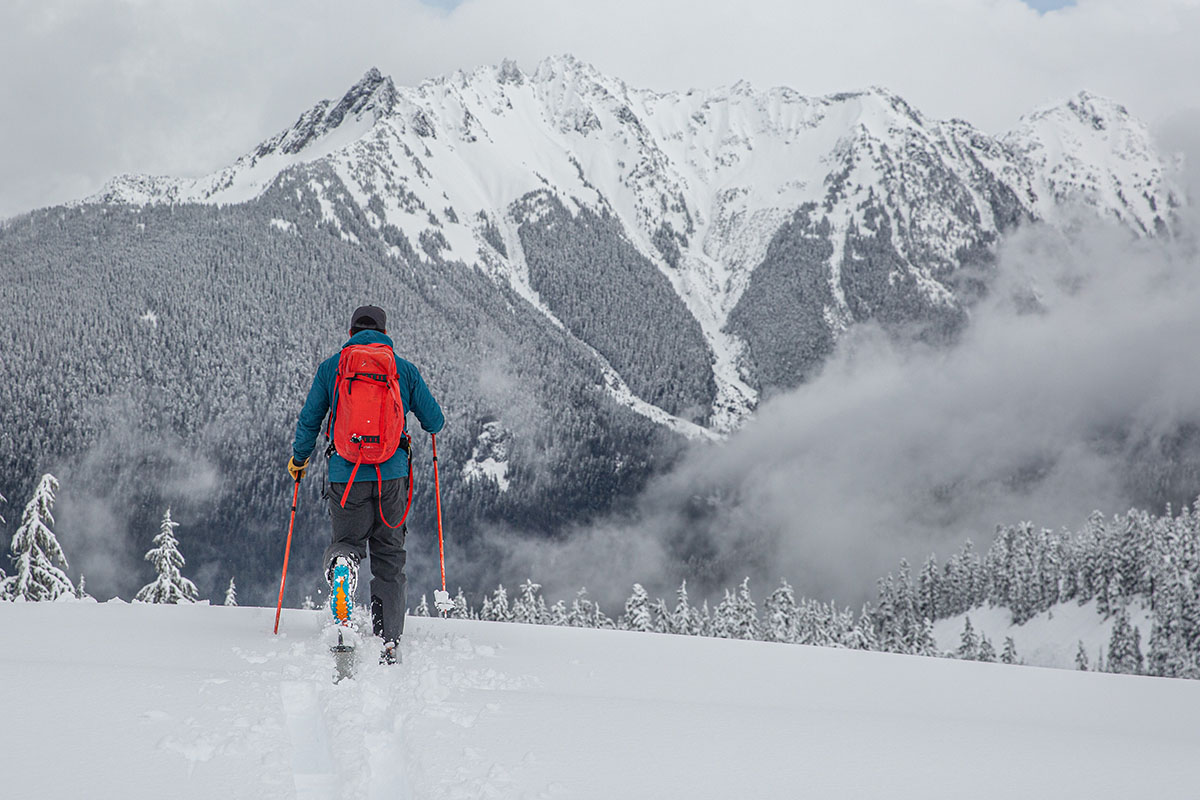
Like the Scarpa Maestrale RS that I tested a few seasons back, the Maestrale XT’s closure system comprises three easy-to-adjust and high-quality buckles and one power strap. The two upper buckles give the boot a real alpine feel and provide ample support over the overlapping cuff, while the single buckle over the forefoot effectively tensions the lower portion. Dubbed the Wave Closure system, this lower buckle works by pulling two points of a self-equalizing cable taut, effectively eliminating the need for an additional buckle. In addition to shaving weight and contributing to the boots’ sleek looks, this streamlined system also helps minimize the risk of pressure points at the top of the foot. I did struggle initially with learning how to properly dial in tension, but I had the process down pat after just a couple of ski days. To really fine-tune things, you can also adjust the length of the buckles by twisting the attachment loops, and the receiving hooks on the cuff can be moved horizontally with a simple screwdriver adjustment.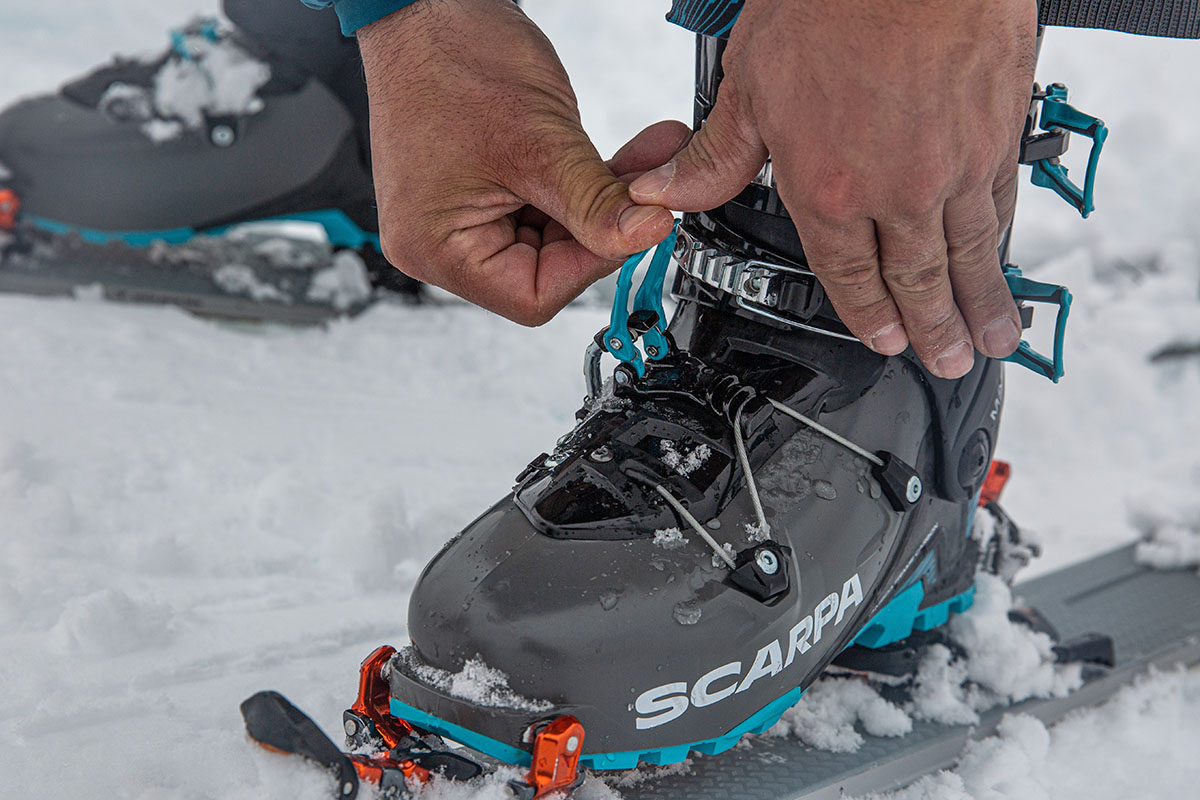
As I touched on above, the power strap is equally well executed and makes it very easy to adjust tightness around the cuff. There’s a bit of stretch to the fabric to really snug things down, and the elasticity also contributes to the boot’s progressive flex and overall comfort. Another thoughtful touch is the hook-based tensioning system, which allows you to loosen the strap for skiing by disengaging the cam without undoing it completely. This helps make the transitioning process quicker and easier and is much more effective than standard Velcro designs, in my opinion. I still have to undo the hook when taking the boots off to create enough room to get my feet out, but it’s nevertheless a reliable and very convenient system. Finally, Scarpa included a RECCO reflector hidden in the strap to help rescuers find you in the event of a backcountry emergency. 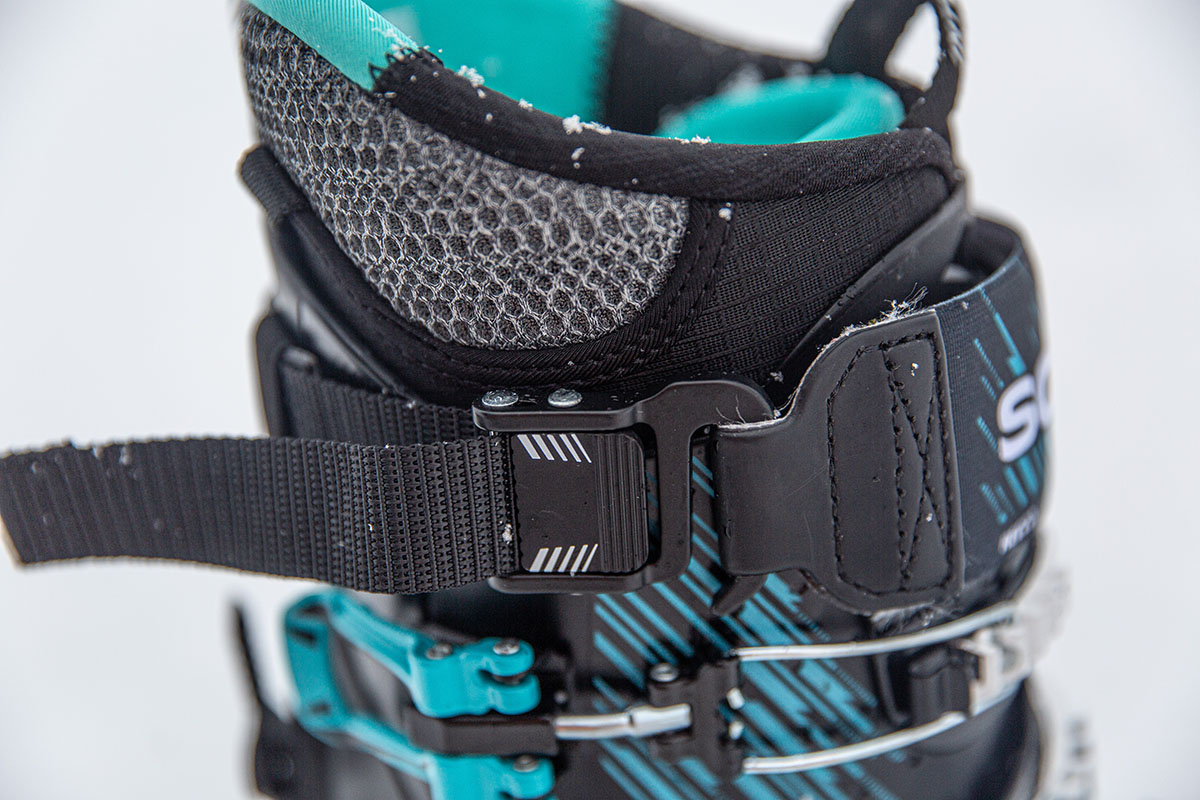
Scarpa recently revamped their Speed Lock ski/walk mechanism, and I’ve been very pleased with the changes. For reference, the Speed Lock lever on my past-generation Maestrale RS boots was prone to icing up and required frequent cleaning to effectively lock the boot into ski mode (I outline this in more detail in my in-depth Maestrale RS review). To solve this issue, the latest Speed Lock XT variation is depressed into the spine and therefore less exposed to the elements. I have had the lever unexpectedly engage in ski mode while touring, but this only happened in heavy, wet snow when my pant cuffs got caught above the lever and pushed it down. Importantly, the lever has stayed securely in place while skiing and is easy to operate with gloves on thanks to the small pull tab at the bottom. 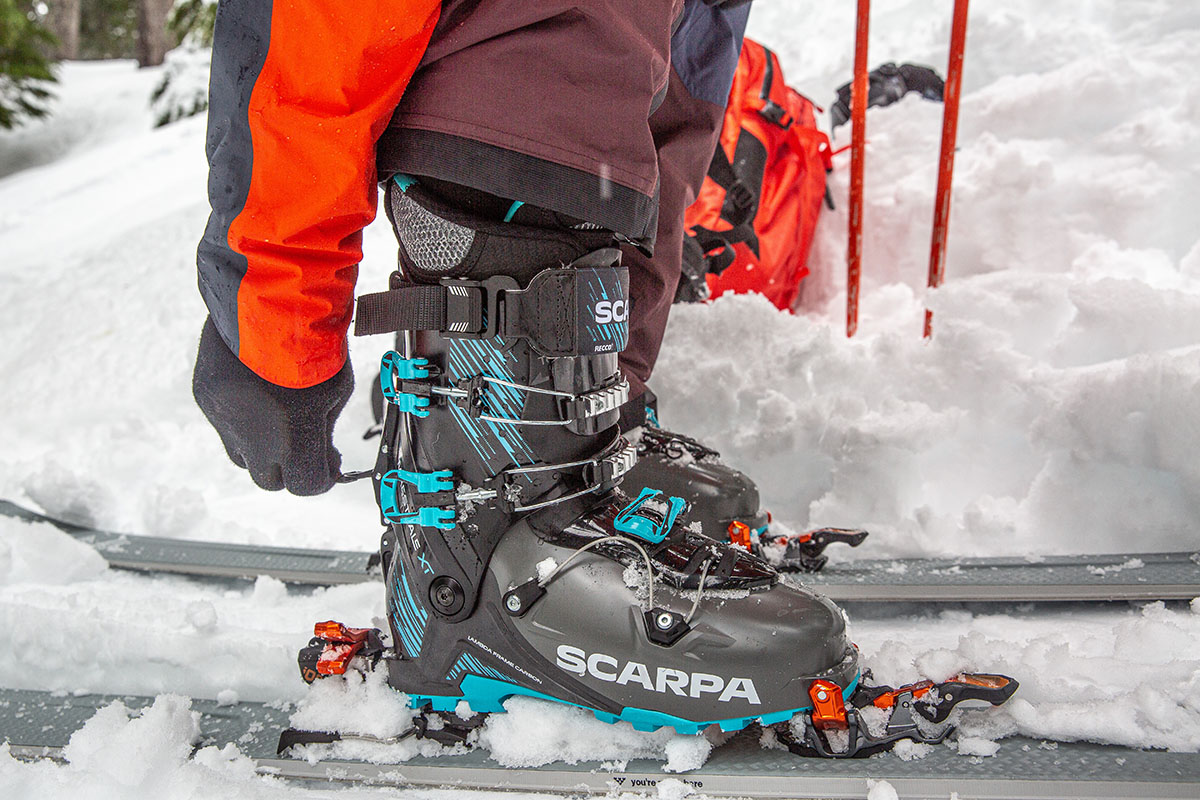
I’ve had very positive experiences with Intuition liners in the past, and the same held true when testing the Scarpa Maestrale XT. In this case, Scarpa used their Pro Flex Ride variation that offered great out-of-the-box comfort and nicely conformed to my foot after a short break-in period with no heat molding required. I’d say the foam is about average in terms of thickness—the liner isn’t particularly plush but is cushioned enough that I can’t feel the buckles when they’re cinched tightly. Temperature regulation is good, too: The liner breathes well enough that I haven’t experienced sweaty feet but also offers adequate insulation to keep my toes warm even when submerging the boots in wet snow for hours on end. Finally, although a small feature, the tongue and cuff loops are nicely sized and easy to grab with gloves to assist in getting the boots on and off.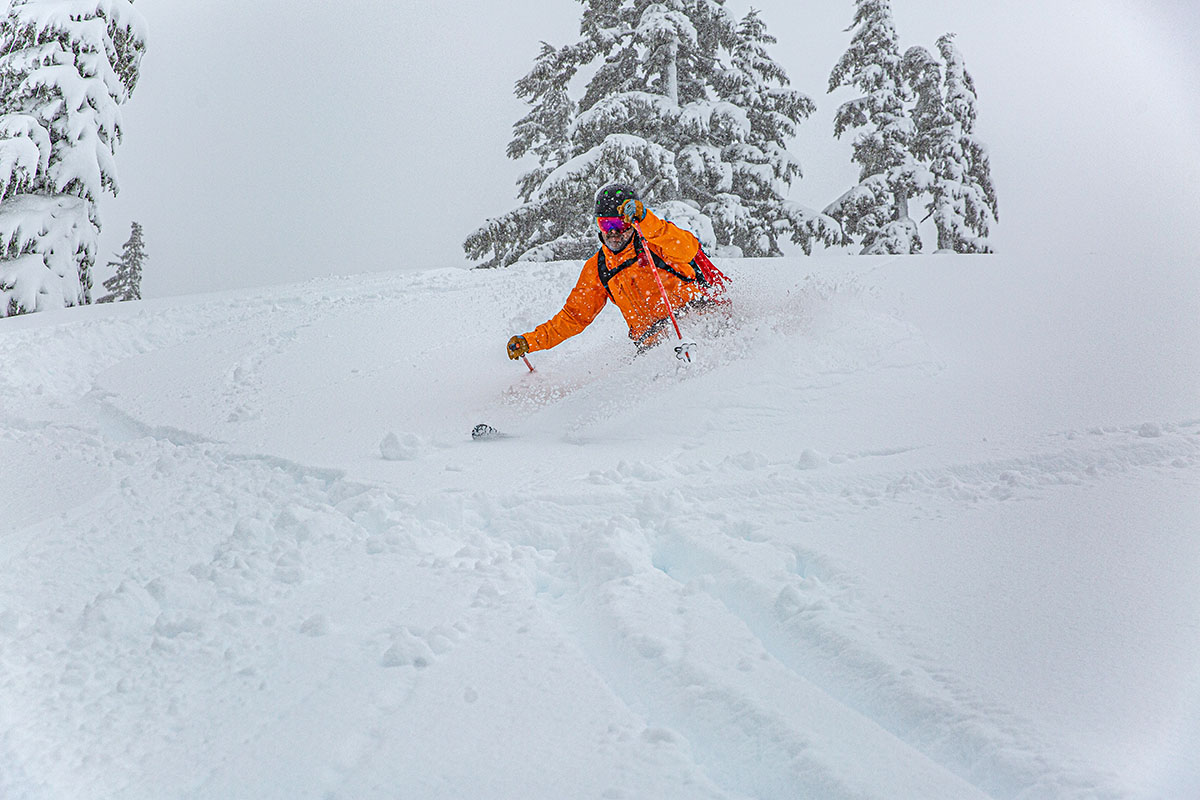
As expected from Scarpa and at this price point, the Maestrale XT is a decidedly premium boot with all the hallmarks of a high-end backcountry design. Every detail has been thoughtfully executed, from the carbon fiber-infused shell and Grilamid cuff to the innovative Wave Closure system and intuitive ski/walk lever. And importantly, my boots are in great shape after extensive use: The Intuition liner is still supple with no signs of packing out, the Vibram soles look like new with no noticeable deterioration or cracks in the rubber, and all of the smaller components—including the buckles and cables on the shell—are fully intact and functioning flawlessly. There’s some slight cosmetic wear along the cuff and lower boot and minor scratches on the tech pin inserts from not aligning my boots properly, but neither of those are surprising given my rigorous testing. 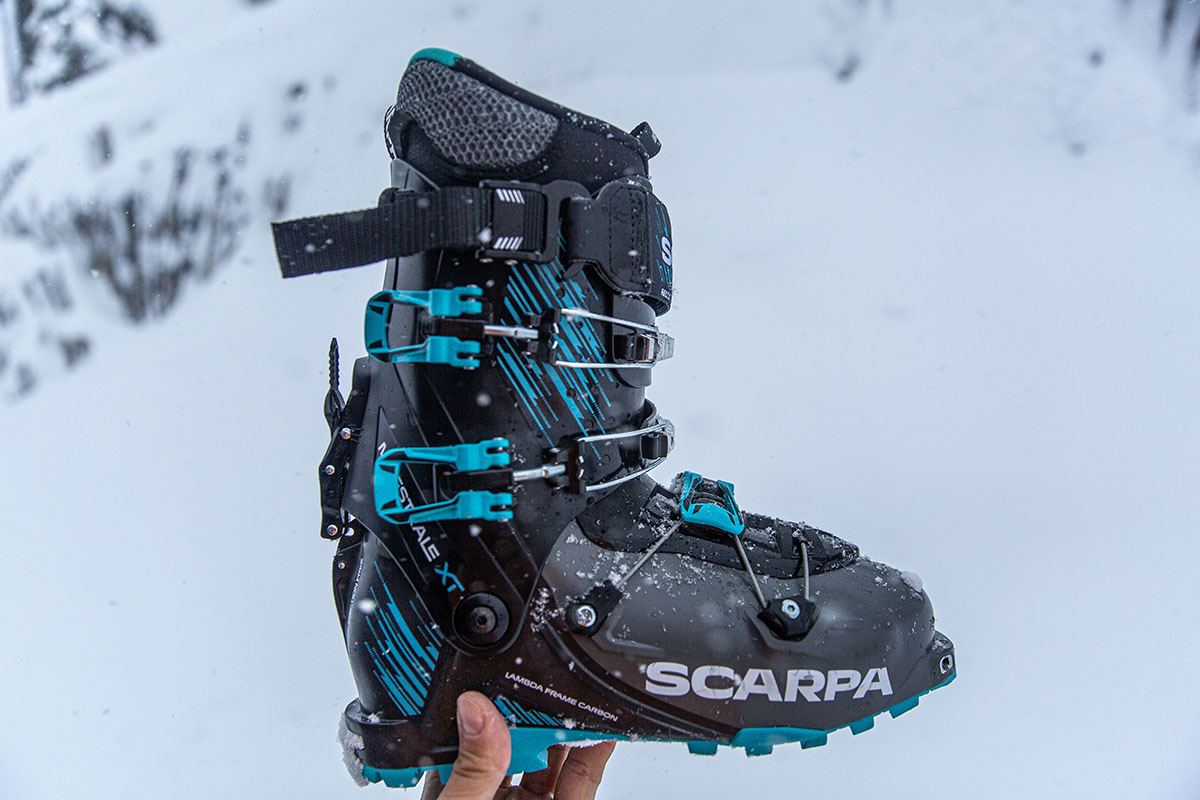
As with my Maestrale RS, I ordered a size 28 in the Scarpa Maestrale XT, which shares the same 314-millimeter sole length. I should note that I have pretty finicky feet and almost always need to get my boots heat molded to increase the width of the toe box, and the Maestrale XT was no exception. To be fair, the boots have a relatively wide 101-millimeter last for accommodating a wide range of foot sizes and shapes, and the Intuition liner will start molding to your feet after just a couple break-in sessions. I opted to get the boots punched since I was still experiencing rubbing along my baby toes after several outings, but I’d recommend taking a few tours before deciding on heat molding.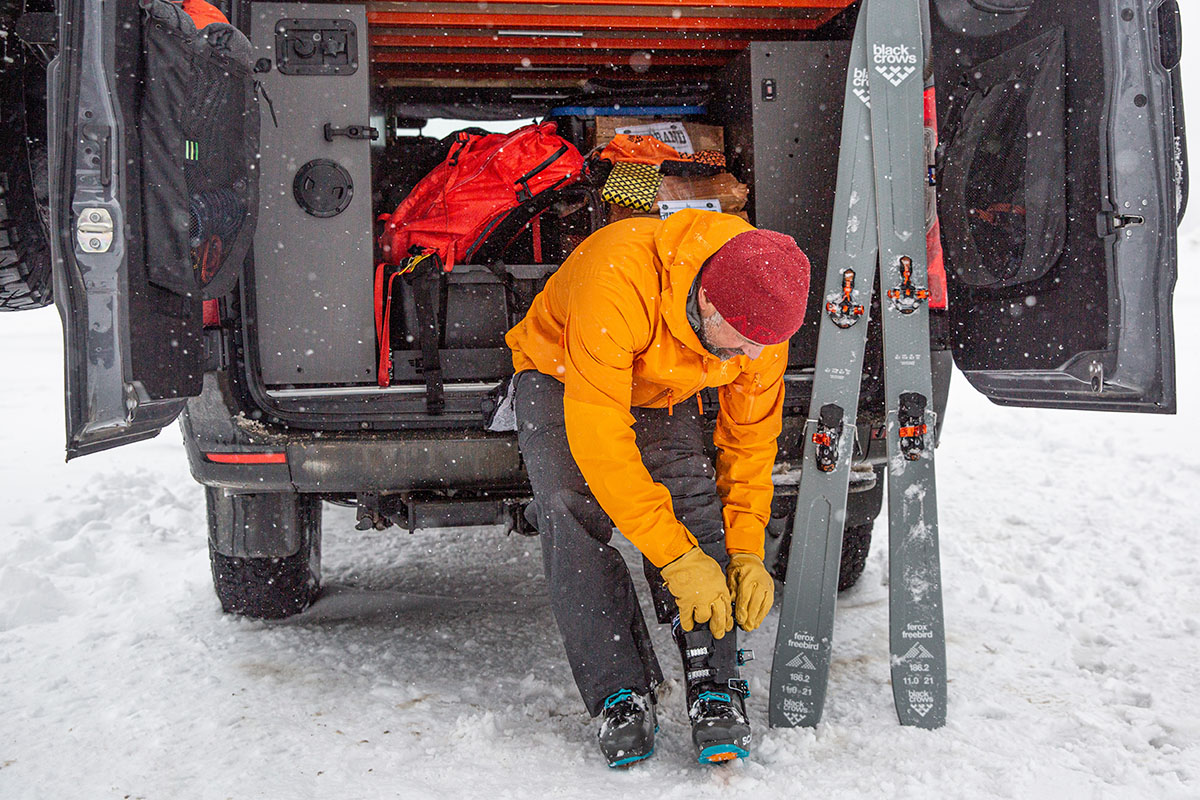
That said, there are a few fit intricacies to be aware of. Compared to the Maestrale RS, the XT forgoes the ratcheting strap connected to the middle buckle, which runs across the forefoot and helps lock down the heel. Without it, the XT’s heel cup leaves some unwanted room for my heel to move around and caused mild rubbing at the inside of my ankle. It hasn’t led to any blisters, and tightening the lower buckle while skinning has reduced most of the play, but it’s something to be aware of if you have particularly narrow heels. I also managed to overtighten the power strap several times and inadvertently cut off circulation to my feet—you’ll want to take the strap’s stretchiness into account when dialing in fit for the descent. Finally, as I mentioned above, the boots’ 2-degree forward lean led to some minor toe bang on steeper slopes, which may cause issues for aggressive riders who prefer a tighter, more performance-focused fit.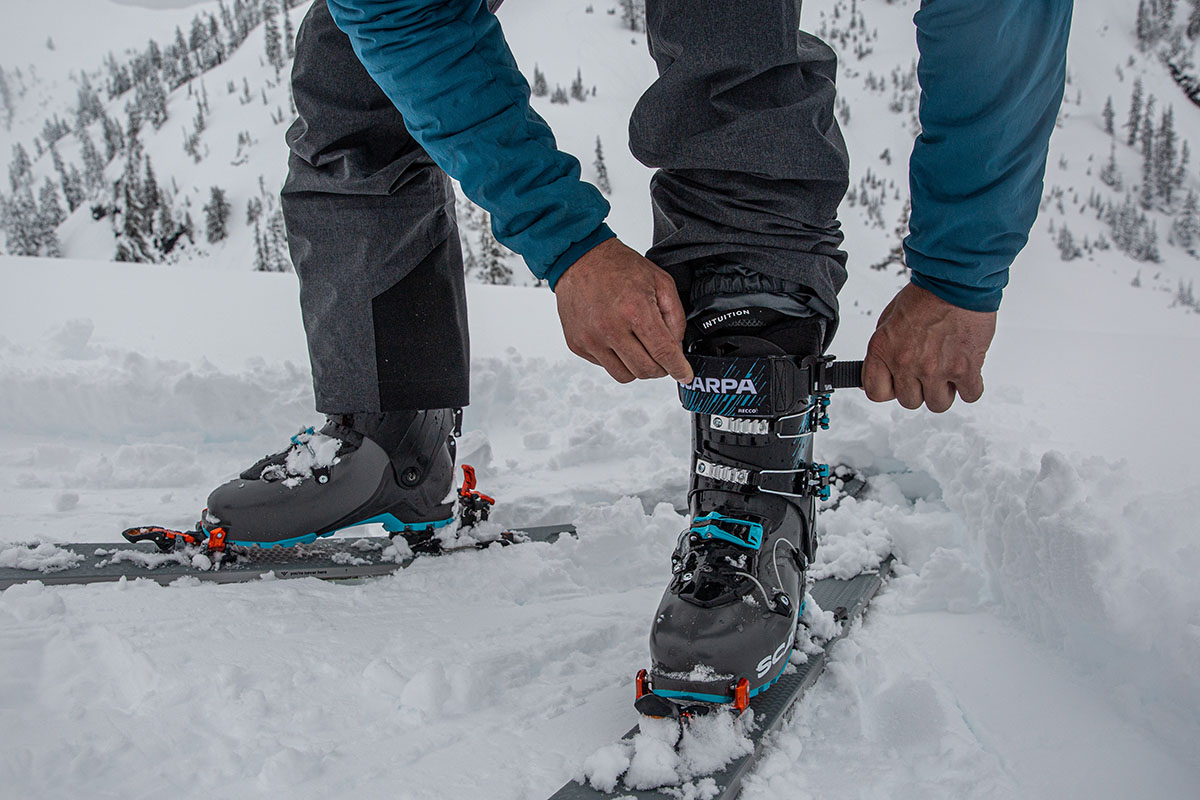
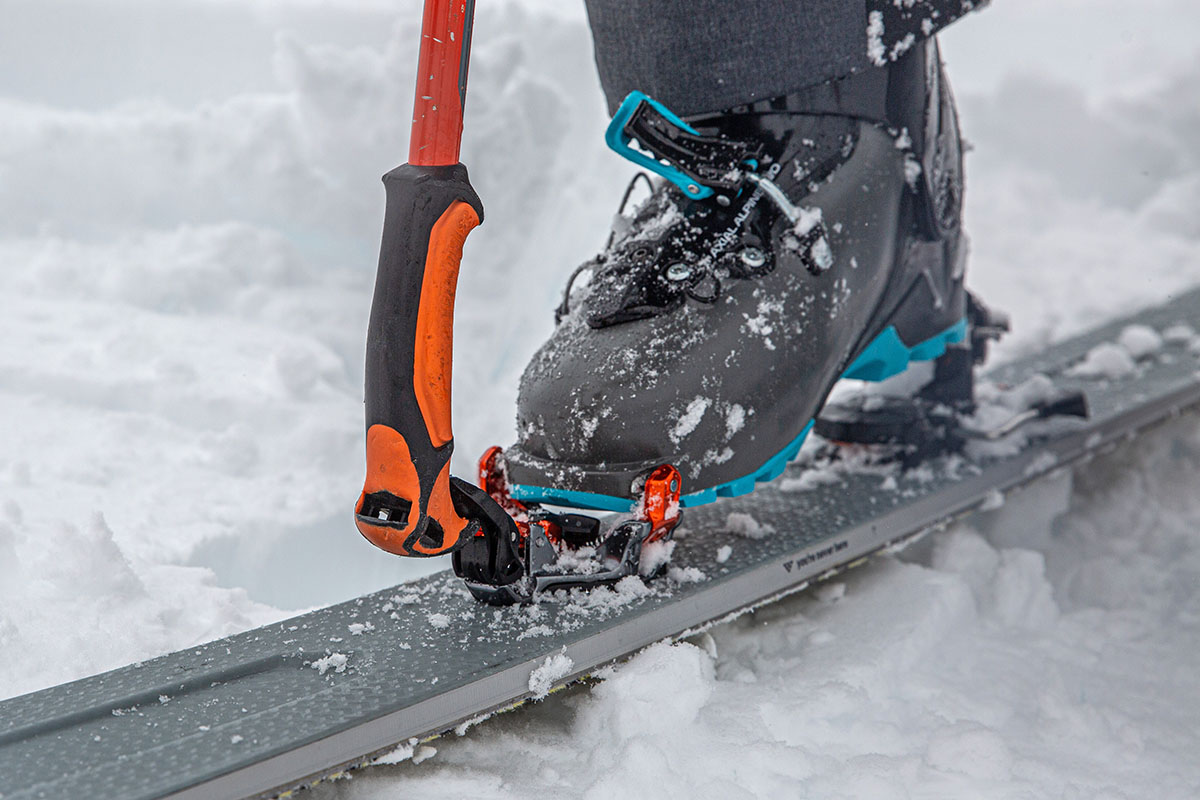
| Boot | Price | Weight | Last | Flex | Motion | Shell |
|---|---|---|---|---|---|---|
| Scarpa Maestrale XT | $929 | 6 lb. 9.8 oz. | 101mm | 130 | 56° | Grilamid, carbon |
| Dynafit Hoji Free 130 | $900 | 6 lbs. 13.3 oz. | 102mm | 130 | 55° | Grilamid |
| Lange XT3 Free 130 LV GW | $850 | 7 lbs. 14.3 oz. | 97mm | 130 | 53° | Polyurethane |
| Tecnica Cochise 130 DYN | $800 | 8 lb. 3 oz. | 99mm | 130 | 50° | Polyurethane |
| Rossignol Alltrack Elite 130 | $850 | 7 lb. 10.8 oz. | 98mm | 130 | 50° | Grilamid |
| Scarpa Maestrale RS | $849 | 6 lb. 6.3 oz. | 101mm | 125 | 60° | Grilamid, carbon |
The Scarpa Maestrale XT has quickly become one of my favorite backcountry ski boots thanks to its effective balance of up- and downhill performance. But the market is flush with options in 2022, and Dynafit’s Hoji Free 130 is another standout all-rounder. Like the Maestrale, the Hoji Free has a stiff 130 flex, solid 55 degrees of cuff rotation, generous last (102mm), and manageable weight of just under 7 pounds per pair. We especially like the innovative Hoji Lock System, which locks the spine and cuff together in a stiff forward lean for a closer-fitting, more alpine-centric feel on the descent. Importantly, the system is easy to use, functional, and saves significant time when transitioning. In my opinion, the biggest difference is all-day comfort: The Hoji Free’s SIDAS liner feels noticeably thin in a few areas and lacks arch support compared to the Maestrale’s more premium Intuition design. Combined with the Scarpa’s small advantages in weight and flex, we consider the Maestrale XT the slightly more well-rounded design.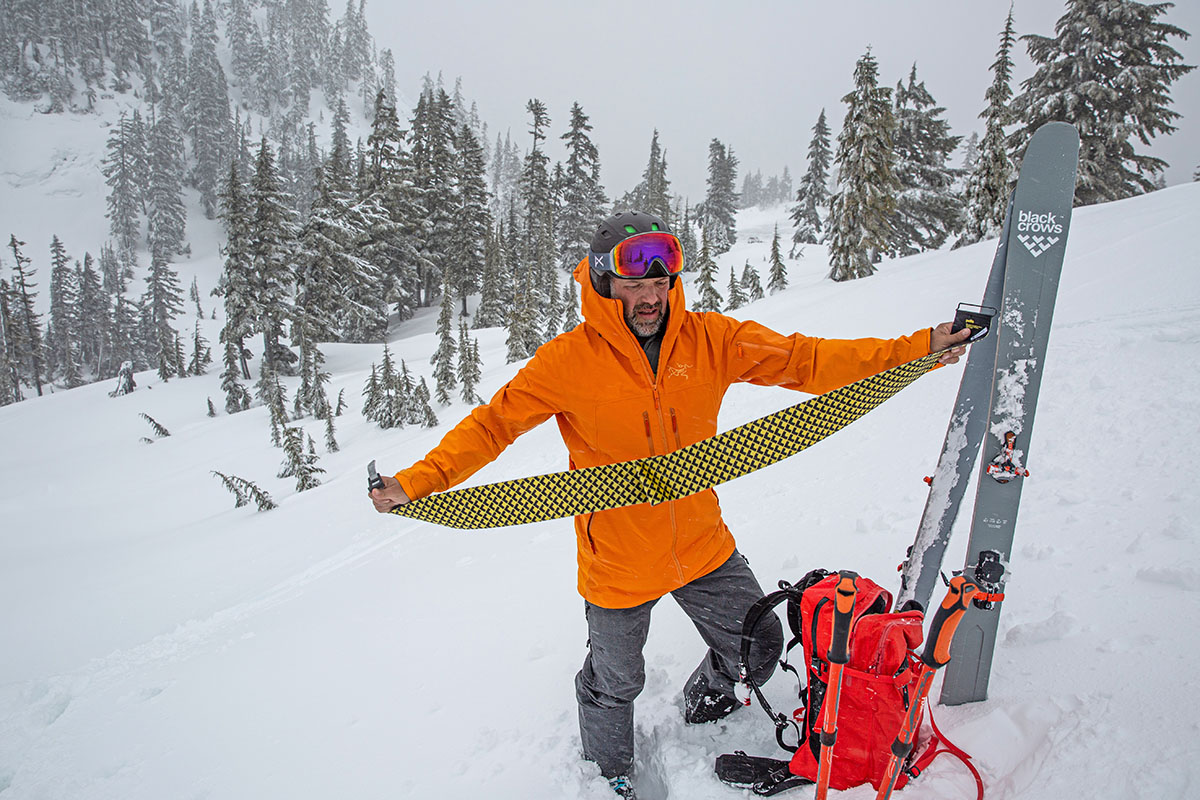
Another one of my favorite downhill-focused designs is Lange's XT3 130, and the latest version is the XT3 Free 130. While both share a strong 130 flex, the Lange gets the edge in downhill capabilities with a four-buckle-and-power-strap layout that allows for a snugger and more performance-oriented fit—particularly helpful when skiing big lines and aggressive terrain. On the flip side, the Maestrale wins out for touring with added range of motion (56 degrees vs. 53 for the Lange) and less heft. For reference, I had to revert to using my bindings’ heel risers far more often on steep inclines when wearing the XT3s compared to the Maestrales, and the GripWalk outsole is less versatile than the Scarpa’s Vibram design, especially in icy conditions (for more, read our in-depth XT3 130 review here). Finally, the low-volume shape (97mm last) won't work with wider feet, although Lange does sells a 100-millimeter MV version. In the end, the XT3 is a viable pick for mixed resort and backcountry use, but the Maestrale is the better dedicated backcountry companion.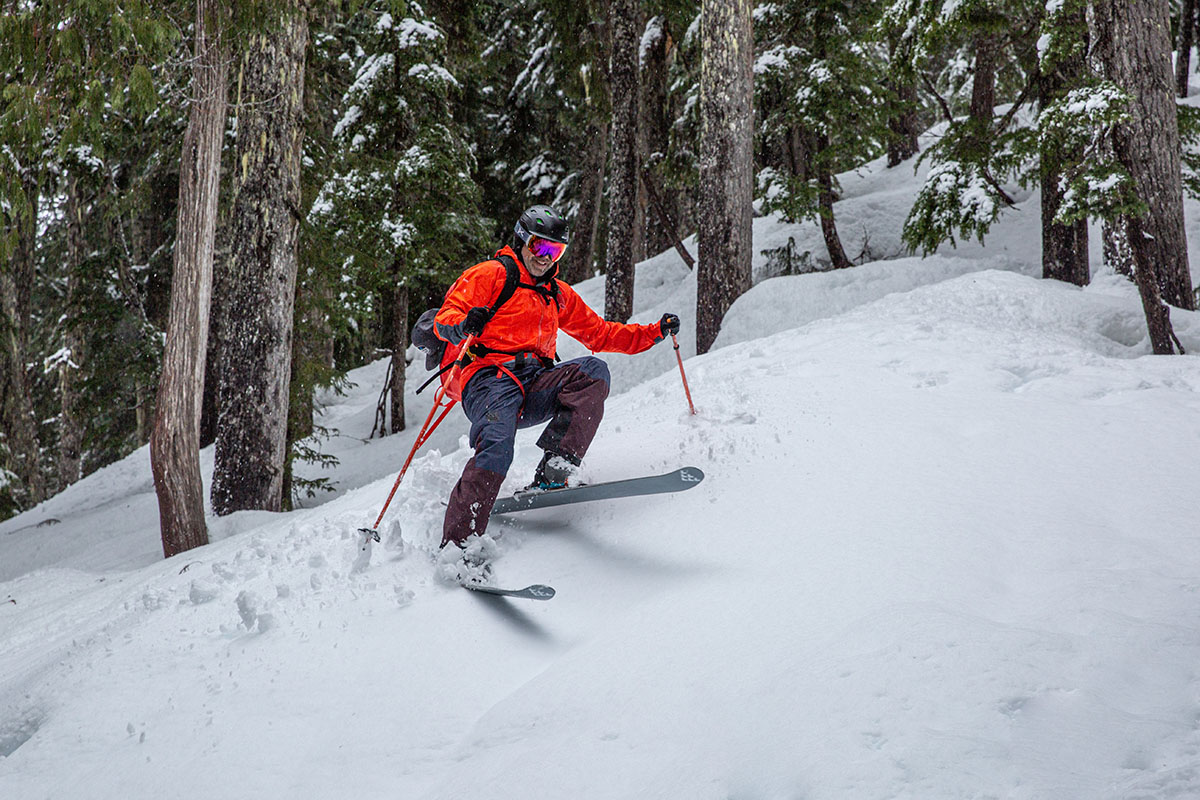
Next up is Tecnica’s Cochise 130 DYN GW, which has similar intentions as a touring boot with impressive downhill capabilities. For a considerable $129 less than the Maestrale XT, the Cochise retains excellent stiffness with a true 130 flex, boasts a four-buckle-and-power-strap layout for really locking things down on the descent, and is highly customizable with a heat-moldable shell and liner. As we saw with the Lange XT3 above, however, the Cochise isn’t a standout in the touring department: The 50-degree cuff rotation is respectable but falls short of the Maestrale XT’s 56-degree range of motion, and the 8-pound-3-ounce build is noticeably hefty on the skin track. In the end, we consider the Cochise a really capable option for heli/t-accessed terrain and resort skiers who frequent the sidecountry, but committed backcountry-goers will be better off spending up for the Scarpa.
Rossignol’s Alltrack Elite 130 LT GW is another freeride-oriented design to have on your radar and swings even farther toward the downhill end of the spectrum than the Maestrale XT. In fact, in ski mode, the Alltrack feels like a true alpine boot with an aggressive stance, four sturdy buckles, and stiff-but-precise shell that offers excellent power transfer. It also has a lower-volume, 98-millimeter last, which won’t work for all foot shapes but is a good match for hard chargers with average to narrow feet. Where the Alltrack falls short is on the uphill: The boots are over a pound heavier per pair, the ski/walk lever is decidedly rudimentary with very little flexibility and give, and range of motion (50 degrees) is limited for extended skinning. Again, the Maestrale does sacrifice some power and stability on the way down with a softer build and one fewer buckle, but we consider it the more balanced option for those who spend most of their season in the backcountry. 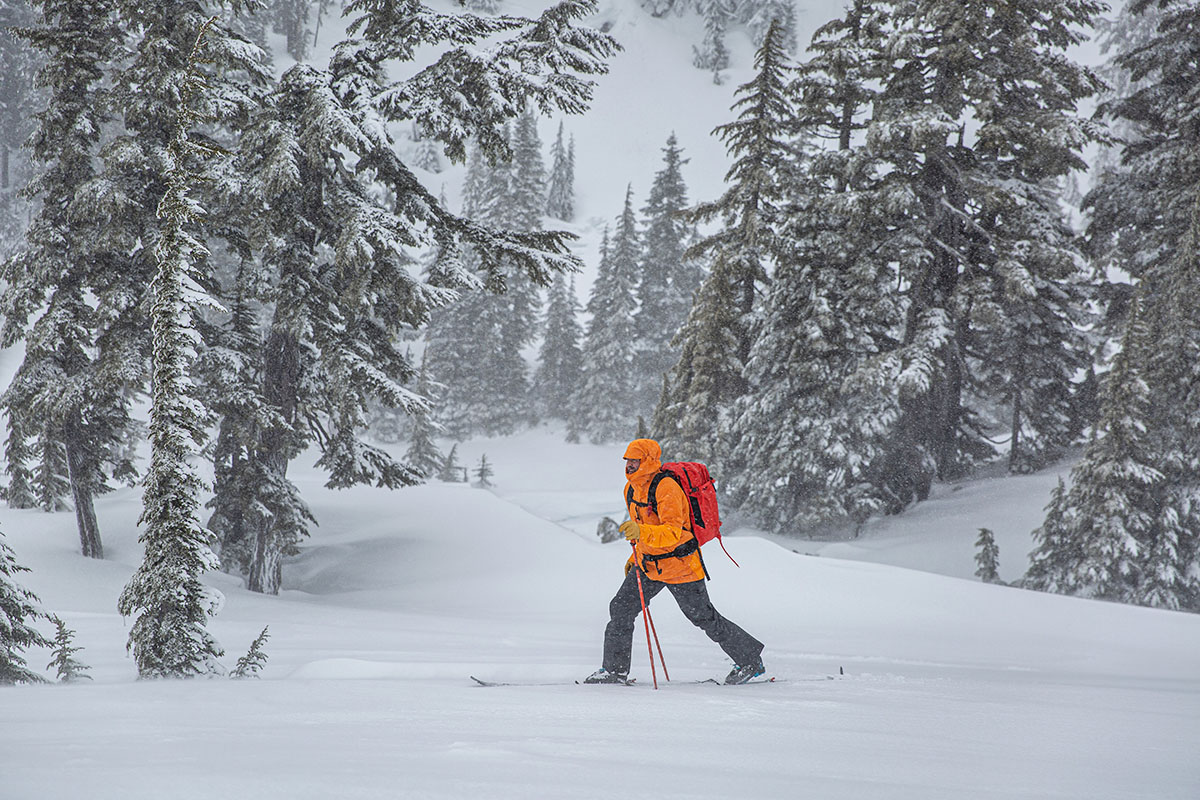
Last but not least is Scarpa's own Maestrale RS, which is a softer and less aggressive variation of the XT. In parsing out the differences, the RS boasts a more forgiving 125 flex, offers better range of motion with 60 degrees of cuff rotation, and shaves off a couple ounces of weight. Both boots have Grilamid shells with carbon reinforcements at the lower portion, although the XT’s rides a little higher and has a wider cuff. There are also small differences in the buckle/strap systems: While both models have three buckles and utilize Scarpa’s Wave Closure system, the XT foregoes the ratcheting strap over the instep and trades the RS’ Velcro-based power strap for the stretchy, cam-secured design that I love. A final difference is price: The RS retails for $80 less than the XT. In the end, we'd break it down as follows: For hard chargers who prioritize downhill performance above all else, spend up for the XT; for backcountry riders who like to earn their turns and don't necessarily need the added stiffness and power, the cheaper RS is plenty capable.